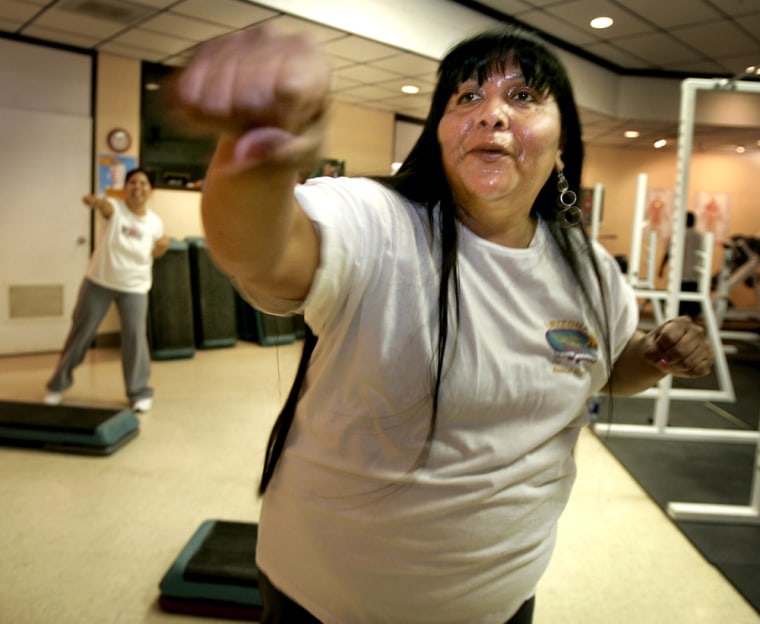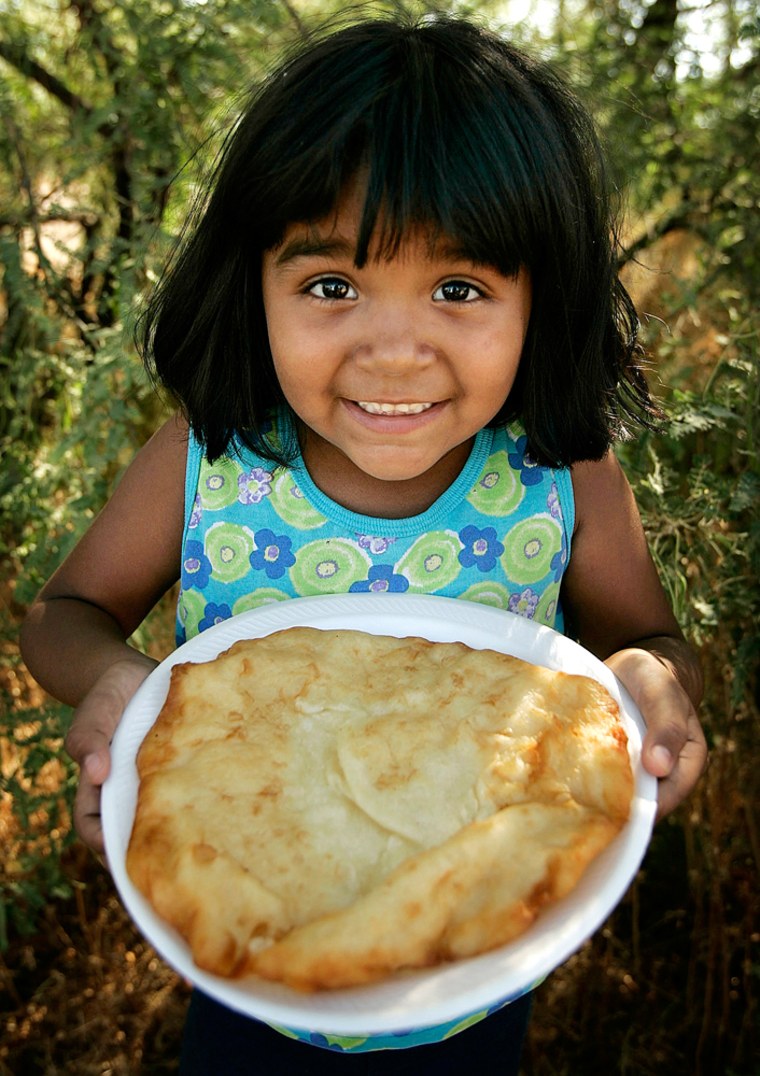When you first see it, plopped down on a paper plate in all its caloric bliss, the round, doughy treat is so appealing, so alluring it’s hard to believe this wondrous sight can cause anything but delight.
But fry bread, that fluffy concoction American Indian women lovingly make in their kitchens and people line up for at powwows and western fairs, has come under attack as a hazard to health.
Suzan Shown Harjo, a Cheyenne and Muscogee Indian, wasn’t trying to cause a debate. She just was exhausted with yet another one of her relatives dying of diabetes. She zoned in on fry bread as a culprit and whipped out a January column for Indian Country Today declaring it junk food that leads to fat Indians.
She made a New Year’s resolution to abstain from fry bread. Then she did something some Indians consider insane: She asked them to give it up, too.
Word spread through Indian Country. Outrage! The nerve of Harjo! What started as a woman’s disdain for the yummy delicacy suddenly became the great fry bread debate. Ask any Indian about it and you’ll either be greeted with rolled eyes — or sparkling, hungry eyes.
After all, fry bread is synonymous with Indian culture. South Dakota has just made it the official state bread. And many Indians don’t want anyone coming between them and their hot, greasy skillets.
“It’s like giving up turkey at Thanksgiving,” said Gayle Weigle, an Anishinabe Indian who runs a Web site celebrating fry bread stories and recipes. “It is a tradition.”
Delicious and loaded with calories
Indian women like Margarita Gonzalez on the Tohono O’odham reservation here rise before dawn to start making fry bread. Gonzalez makes four dozen each morning and makes her living selling them in an empty lot in Sells.
“It’s like a craving you get for it, the aroma of it. You have to try to keep yourself from it,” she said, taking a break from serving the lunch crowd.
To say fry bread is tasty isn’t doing it justice. It’s scrumptious, sweet, and puts a crazy spell on anyone who craves it.
But it’s loaded with pesky calories — at least 700 for one paper-plate size piece — plus a whopping 27 grams of fat, according to a nutritional analysis by the U.S. Department of Agriculture.
“Those things are awesome,” tribal police officer Mario Saraficio said, getting excited at the thought. “It’s bad, but it’s good. If the doctor told me I had to give it up, I’d say probably not.”
Fry bread came to be by necessity. When the government moved Indians off their land and onto reservations in the 1800s, they were kept from their traditional foods such as elk, corn, deer and rabbit. In their place were rations of flour, salt and lard, and Indian women did what they could with it, creating the wonderful fry bread that would become part of their culture.
Ingredients vary today, but the main ones are still white flour, salt, sugar and lard. Some call it a popover, and options are endless for how to eat it. There’s the Indian taco, fry bread with red chili and beans, or the extra sweet version with powdered sugar or honey on top.
In Phoenix, there is the popular Fry Bread House restaurant, where you can get fry bread pretty much anyway you want. The most sinful? Fry bread topped with gooey chocolate syrup and oozing with butter.
Sure, folks there talked about the fry bread flap, but it didn’t seem to make much difference.
“They’re still in line,” said restaurant owner Cecelia Miller.
Fry bread is so embedded in the culture many Indians can’t imagine going without. T-shirts declare “Fry Bread Power Forever!” or “FBI — Fry Bread Inspector.” There’s an entire Web site dedicated to warm, fuzzy memories about fry bread.
So Harjo’s column was the equivalent of taking spray paint to sacred petroglyphs.
Harjo, who heads the Morning Star Institute, an Indian rights group, compared fry bread to a “lead Frisbee” and even likened it to “hard-core porn. No redeeming qualities.”
“It’s the connecting dot between healthy children and obesity, hypertension, diabetes, dialysis, blindness, amputations and slow death,” Harjo wrote, deeming it, quite simply, “Rotten stuff.”
Hot topic
On the national radio show Native America Calling, the fry bread furor was one of the most popular topics this year. One man boasted that he downed 12 pieces in one sitting. Another man said he was desperate for fry bread and couldn’t find any.
“Anytime you say fry bread, people smile. Except Suzan Harjo,” Weigle said. “It’s almost sacred. It just makes you happy.”
Weigle originally started her Web site www.frybreadlove.org to talk about a benefit concert for the homeless children she worked with in Minneapolis. Why that name? To her, fry bread means comfort. Soon, she was posting fry bread recipes, pictures and heartwarming stories. She’s thinking now of a recipe book.
High rate of diabetes
Not every case of obesity and diabetes among Indians can be blamed solely on fry bread, of course. But Harjo has a point.
Among Indians, the prevalence of Type 2 diabetes — the most common form — is more than double what it is in the general population. Fueled by obesity, poor diet and a sedentary lifestyle, Type 2 diabetes is occurring a full decade sooner in Indians, when people are between 20 and 29 years old.
Many believe the diabetes rate began to skyrocket when Indians stopped living off the land and began using government rations. For decades, researchers with the National Institutes of Health have been studying the Pima Indians in Arizona, who have the highest incidence of diabetes in the world, to determine if there is a genetic reason they are more susceptible to the disease.
Here on the Tohono O’odham reservation near Tucson, more than half the 14,000 residents have diabetes. A $4 million dialysis center is under construction, necessary to serve all the people who have developed kidney disease from diabetes.
At the Sells hospital, it’s unusual for doctors to see a tribal member who doesn’t have diabetes. It is so prevalent, doctors and nutritionists struggle to convince Indians they can help prevent it.
The attitude is, “I’m going to get it anyway,” Dr. Paul Weintraub said. “And to some extent, it’s true. They will get it.”
Gloria Maldonado has lived with diabetes for 22 years. Her mother had it, so does her brother and her 24-year-old daughter.
“I figured sooner or later I would get it,” she said as Weintraub examined her.
Overall diet blamed
Fry bread didn’t get Maldonado, 53, in this situation by itself, of course. She struggles to give up junk food and doesn’t exercise. But she has switched from cooking fry bread in lard to dipping it in oil.
“It isn’t the culprit that has made Indian people heavy,” said Tammy L. Brown, nutrition consultant with Indian Health Service’s diabetes division. “It’s the fast foods, the sugary drinks. It’s the overall diet.”
But, if fry bread gets Indians talking about health, then that’s fine by Brown and Harjo.
“Just because it was food that was forced on us doesn’t mean we have to keep embracing it,” Harjo said.
For a long time, Indians have made fun of commodities and even refer to an overweight person as having a “commod bod.” Jokes are tossed around that fry bread has killed more Indians than the federal government.
Confronting the problem
But artist Steven Deo, a Creek and Euchee Indian, said laughing is a way Indians have dealt with obesity and diabetes.
“At some point, we have to confront that,” he said. “We have to prepare the next generation to come out of that poverty, to strive for bigger and better things.”
Deo created a series of public service announcement posters, and debuted his first one — a picture of a big, tan piece of fry bread with the words: “Frybread Kills” — at a show in New Mexico last year.
“It has stirred some controversy,” Deo said. “But at least we’re talking about it now.”
It’s mid-day at the Health O’odham Promotion Program, or the HOPP, and the step class is in full, sweaty swing. Health lessons are postered around the gym, reminding Indians to get their five fruits and vegetables a day and that white bread and rice convert quickly to sugar. Music is blaring, the treadmills are filling up and Mashone Antone, 36, is on her second trip to the community gym today.
Lifestyle changes
Last October she took a hard look at her life: She was overweight and so were two of her three children. They stayed in the house a lot, ate fast food, indulged in fry bread and barely thought about health.

But Antone, a juvenile probation officer, wanted to change that, for her children and for herself.
Now she’s up every day at 5 a.m. for a two-mile walk, then hits the HOPP before work and again after work. She’s shed 30 pounds and wants to lose 50 more. Her daughter often joins her at the gym, and now the family takes walks and plays basketball.
Soda is out, fruits and vegetables are in, and fry bread is now only a rare treat.
“When I think about it, that was my downfall,” Antone said. “I don’t miss it.”
Harjo would be proud.
Facing resistance
But getting someone with Antone’s enthusiasm is a challenge for the gym’s staff. Nutritionists estimate 80 percent of the Tohono O’odham people are obese. They hold a weight loss challenge, fun runs, offer nutrition counseling, even teach people how to shop for healthy food and host a camp for children at risk for obesity and diabetes.
“I do get a lot of resistance from people who say they want to change their eating habits, but don’t want to change the way they cook,” said dietitian Dolores Galaz.
Another attitude Galaz encounters: Indians not wanting to be thin, for fear they will be the odd one out in their overweight families.
In her column, Harjo had some parting advice: “The next time you find yourself swallowing some leftover news du jour or get that suicidal urge for fry bread, just slather lard all over the magazine or television listing and apply it directly to your midriff and backside. That way, you can have the consequence of the rotten stuff, without having to actually digest it.”
The gym staff isn’t as harsh; they’re just hoping to change eating habits little by little. All the better if the fry bread controversy jump-starts that.
“People want to change because they see what’s happening to their elders and their parents. I just think they haven’t known how to go about changing,” Galaz said.
That means losing the lard and white flour in fry bread and trying wheat flour and canola oil, something tribal Chairwoman Vivian Juan-Saunders has started doing.
“I like to eat fry bread, but instead of eating the whole pie, I eat half,” she said.
